DeFi
Le summum de l’innovation DeFi et de la gestion d’actifs
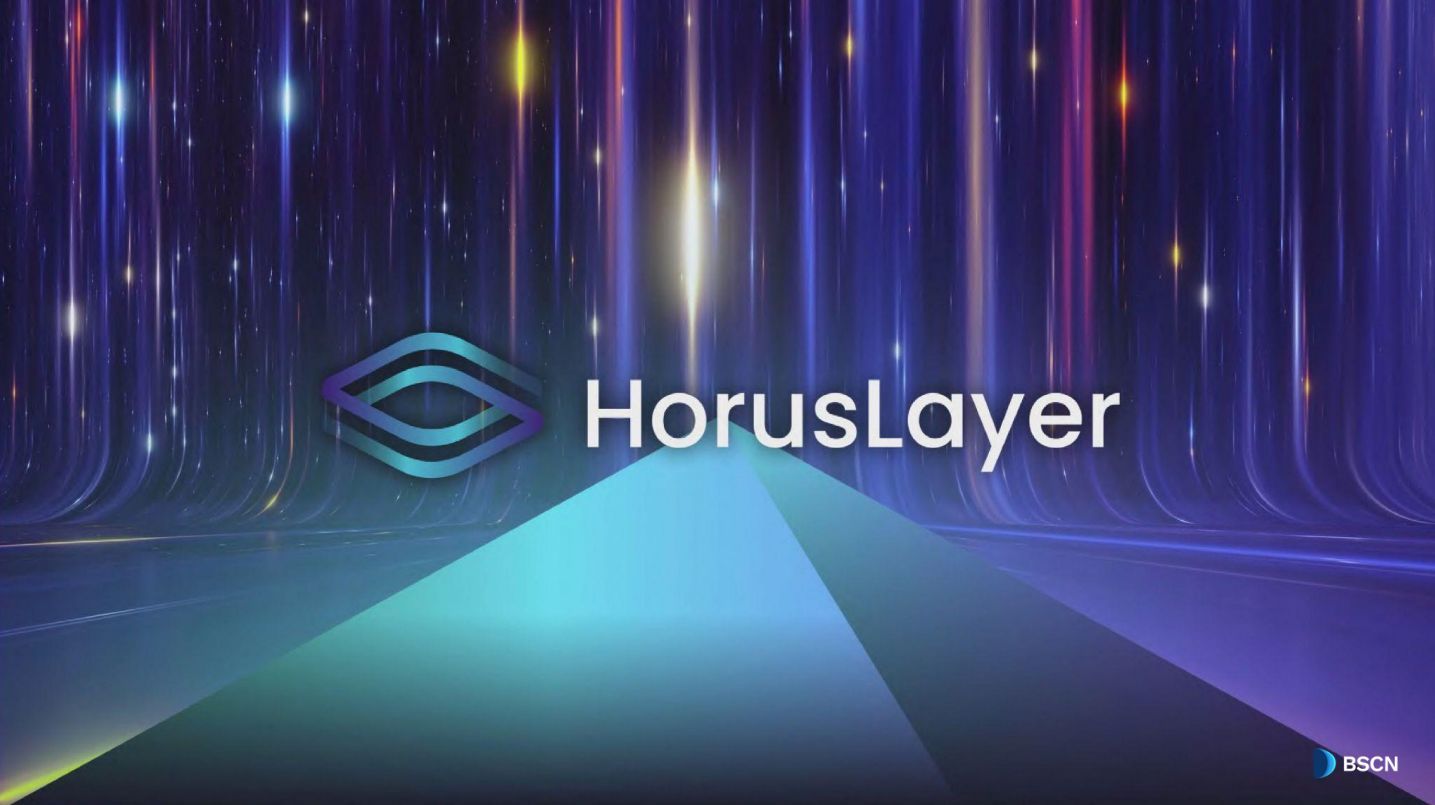
Cet examen complet met en évidence la mission d’HorusLayer visant à démocratiser les opportunités financières et sa feuille de route innovante pour parvenir à l’autonomisation et à l’autonomie financières universelles.
Introduction
HorusLayer se présente comme le centre ultime de l’innovation Defi, permettant aux utilisateurs individuels d’amplifier leurs actifs grâce à des stratégies de reconversion pionnières et des intégrations de gestion astucieuses. Pour les projets, HorusLayer sert de plate-forme polyvalente, facilitant une croissance optimisée des actifs et favorisant le développement durable au sein de l’écosystème dynamique des actifs numériques.
Équipe Horuslayer
Le registraire des sociétés d’Angleterre et du Pays de Galles certifie par la présente
que CUBITX LIMITED est constituée en vertu du Companies Act 2006 en tant que société privée, limitée par actions et dont le siège social est en Angleterre et au Pays de Galles
Décerné à Companies House, Cardiff, le 28 mars 2024
CubitX LTD, leader de l’innovation technologique, se concentre sur la création de solutions de pointe qui accélèrent le progrès des entreprises. D’accord
Fondée par des entrepreneurs visionnaires, CubitX est un acteur clé de l’industrie technologique, aidant les startups à se développer.
devenir une entreprise prospère. HorusLayer, développé par une équipe d’ingénieurs qualifiés et d’experts en blockchain
société technologique.
Nom de l’entreprise : CubitX LTD
Numéro d’enregistrement de la société : 15600231
Emplacement de l’entreprise : Appartement 53 Flaxman Court, Flaxman Terrace, Londres, États-Unis
Les informations ci-dessus sont communiquées par voie électronique et authentifiées par le registraire des sociétés en vertu de l’article 1115 de la loi sur les sociétés de 2006.

Points forts des fonctionnalités
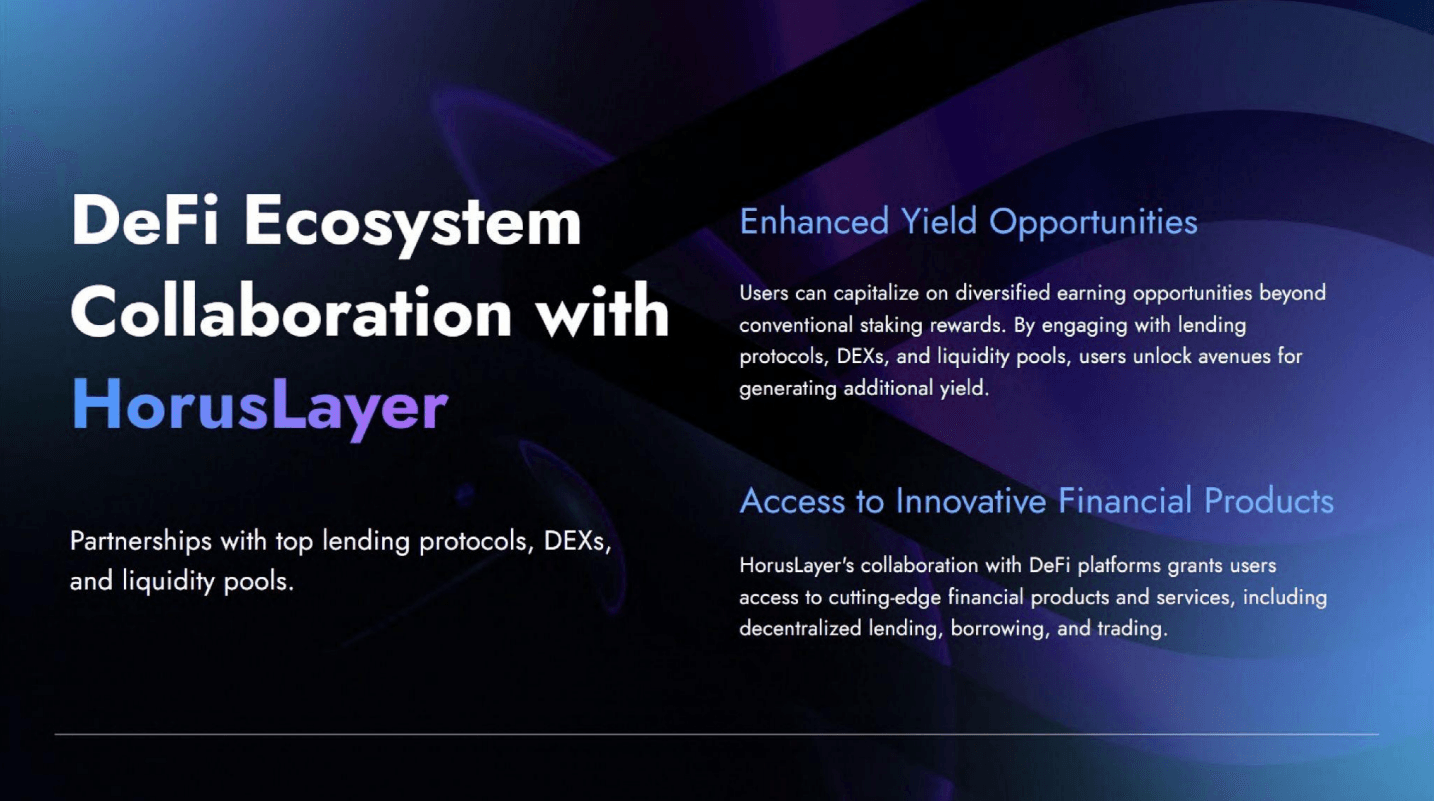
1. Agrégateurs de jalonnement et de LSD optimisés
HorusLayer offre aux utilisateurs la possibilité de gagner grâce à des agrégateurs avancés de jalonnement et de dérivés de jalonnement de liquidité (LSD) alimentés par des algorithmes d’IA. Notre application optimise les stratégies de jalonnement, maximise les récompenses et atténue les risques pour les utilisateurs, garantissant une utilisation efficace des actifs et des rendements plus élevés.
De plus, HorusLayer offre une compatibilité transparente entre les chaînes, permettant aux utilisateurs de miser des actifs sur divers réseaux blockchain. Cette interopérabilité permet une diversification des portefeuilles de jalonnement et l’accès à un plus large éventail d’opportunités de jalonnement, améliorant ainsi la flexibilité et l’utilité pour les utilisateurs.
2. Réseau de validateurs sécurisé
HorusLayer exploite un réseau de validateurs sécurisé sur plusieurs blockchains, qui sert d’épine dorsale à notre infrastructure de jalonnement. Les validateurs jouent un rôle crucial dans la vérification des transactions, la sécurisation du réseau et la recherche d’un consensus sur les réseaux blockchain. En participant au réseau de validateurs, les utilisateurs contribuent à la sécurité et à la décentralisation de la plateforme HorusLayer tout en gagnant des récompenses pour leur participation. Cette fonctionnalité garantit l’intégrité des transactions, améliore la confiance dans le réseau et favorise la décentralisation au sein de l’écosystème.
3. Collaboration avec l’écosystème DeFi
HorusLayer collabore avec les principales plateformes DeFi, notamment les protocoles de prêt, les échanges décentralisés (DEX) et les pools de liquidité. Ce partenariat vise à élargir les opportunités de gains pour les actifs mis en jeu, permettant aux utilisateurs de participer aux prêts, aux échanges et à l’apport de liquidités tout en conservant leurs positions de mise en jeu. En tirant parti des capacités des plates-formes DeFi, les utilisateurs peuvent maximiser l’utilité et la valeur de leurs actifs mis en jeu au sein de l’écosystème HorusLayer.
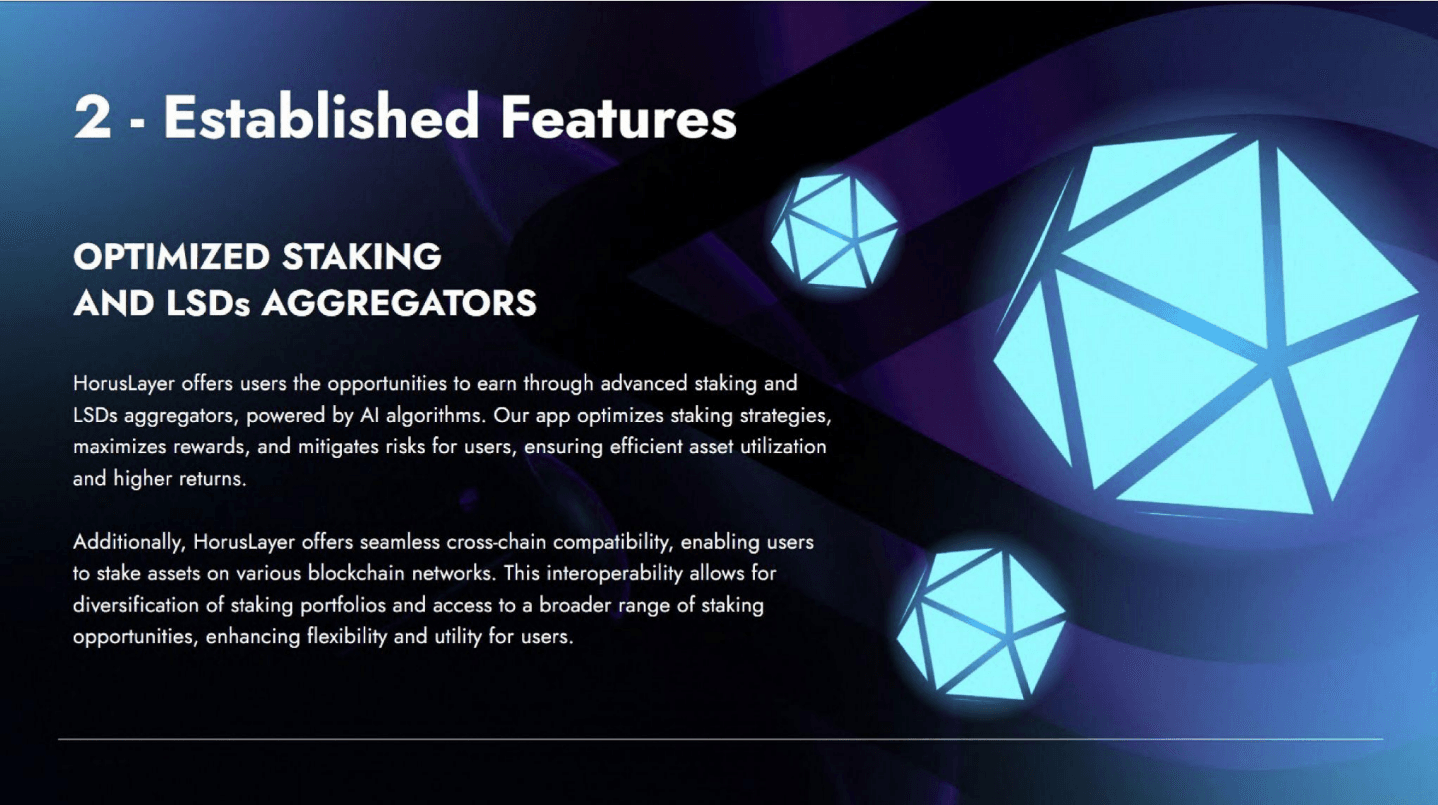
4. Bot commercial HDEX et IA
Horus DEX (HDEX) est une bourse décentralisée proposant à la fois le trading au comptant et à terme, offrant des options de trading polyvalentes. Il comprend le Horus AI Trade Bot, qui utilise l’IA pour automatiser les transactions, optimiser les résultats et améliorer la liquidité du marché. HDEX combine une technologie avancée avec une conception conviviale, établissant une nouvelle norme dans les échanges décentralisés.
5. Gestion automatisée des investissements
Horus propose une suite complète d’outils d’analyse et de gestion de portefeuille, notamment des analyses de marché avancées basées sur l’automatisation et des fonctionnalités de trading de robots. Ces fonctionnalités offrent aux utilisateurs des informations en temps réel, des capacités de trading automatisées et des outils de prise de décision stratégique pour optimiser leurs portefeuilles d’investissement et maximiser les rendements sur les marchés dynamiques de la cryptographie.
6. Nexus de l’innovation : HorusLayer Labs
Horus Labs constitue le lien d’innovation au sein de l’écosystème Horus, servant de catalyseur pour le développement de projets DeFi révolutionnaires. En mettant l’accent sur la promotion de la collaboration, de l’innovation et de la croissance de l’écosystème, Horus Labs propose une suite complète de fonctionnalités et d’outils conçus pour responsabiliser les développeurs, les entrepreneurs et les initiatives communautaires. Des solutions de staking en tant que service aux technologies de mise à l’échelle de couche 2, Horus Labs fournit les ressources et le soutien nécessaires pour mener des projets et des initiatives avant-gardistes qui repoussent les limites de la finance décentralisée.
1. Recherche et développement : innove dans la DeFi grâce à des partenariats, en explorant de nouveaux modèles et technologies.
2. Allocation du Fonds pour l’écosystème : soutient des projets tiers au sein de l’écosystème Horus via des subventions et des financements.
3. Amélioration de l’infrastructure technique : met à niveau l’infrastructure pour améliorer la fiabilité, la sécurité et les performances.
4. Expansion du partenariat : forme des partenariats stratégiques pour développer l’écosystème et améliorer l’accessibilité des services.
7. Intégration du portefeuille matériel
HorusLayer Labs introduit l’intégration du portefeuille matériel, une fonctionnalité révolutionnaire conçue pour améliorer la sécurité, la commodité et la convivialité de notre plateforme. Grâce à une collaboration avec des partenaires accrédités, nous sommes fiers d’annoncer le lancement de la gamme de portefeuilles matériels HorusLayer, adaptés pour répondre aux besoins de nos utilisateurs. Ces portefeuilles matériels offrent aux utilisateurs une solution sécurisée et fiable pour stocker et gérer leurs actifs numériques, offrant ainsi tranquillité d’esprit et confiance dans leurs activités de jalonnement.
8. Carte de débit cryptographique
Grâce à des partenariats stratégiques avec des sociétés accréditées sur le marché financier traditionnel, HorusLayer est fier de dévoiler notre carte de débit crypto révolutionnaire HorusLayer. Conçue pour s’intégrer de manière transparente aux applications décentralisées (dApps) au sein de notre écosystème, la carte de paiement prend en charge à la fois les transactions en crypto-monnaie et en devises traditionnelles, offrant aux utilisateurs une flexibilité sans précédent dans la gestion de leurs finances :
- Intégration transparente avec les dApps de l’écosystème
- Prise en charge des dépenses en crypto-monnaie et en devises traditionnelles
- Conversion instantanée avec Chainlink Oracle
- Récompenses de cashback en crypto-monnaie
Référence Programme
HorusLayer est ravi de présenter notre programme de parrainage, conçu pour récompenser nos précieux utilisateurs pour avoir amené de nouveaux participants dans l’écosystème HorusLayer. Grâce à notre programme de parrainage, les utilisateurs ont la possibilité de gagner des commissions de parrainage et des bonus en fonction des activités de leurs utilisateurs référés, créant ainsi un environnement mutuellement bénéfique pour tous les participants.
Commission de parrainage direct : les parrains gagnent des commissions basées sur les packages de mise choisis par les utilisateurs référés.
- Commission d’intérêt : les parrains gagnent des commissions supplémentaires en fonction des revenus de leurs utilisateurs parrainés.
- Commission de parrainage direct : les parrains gagnent des commissions basées sur les packages de mise choisis par les utilisateurs référés.
Jetons et tokenomiques
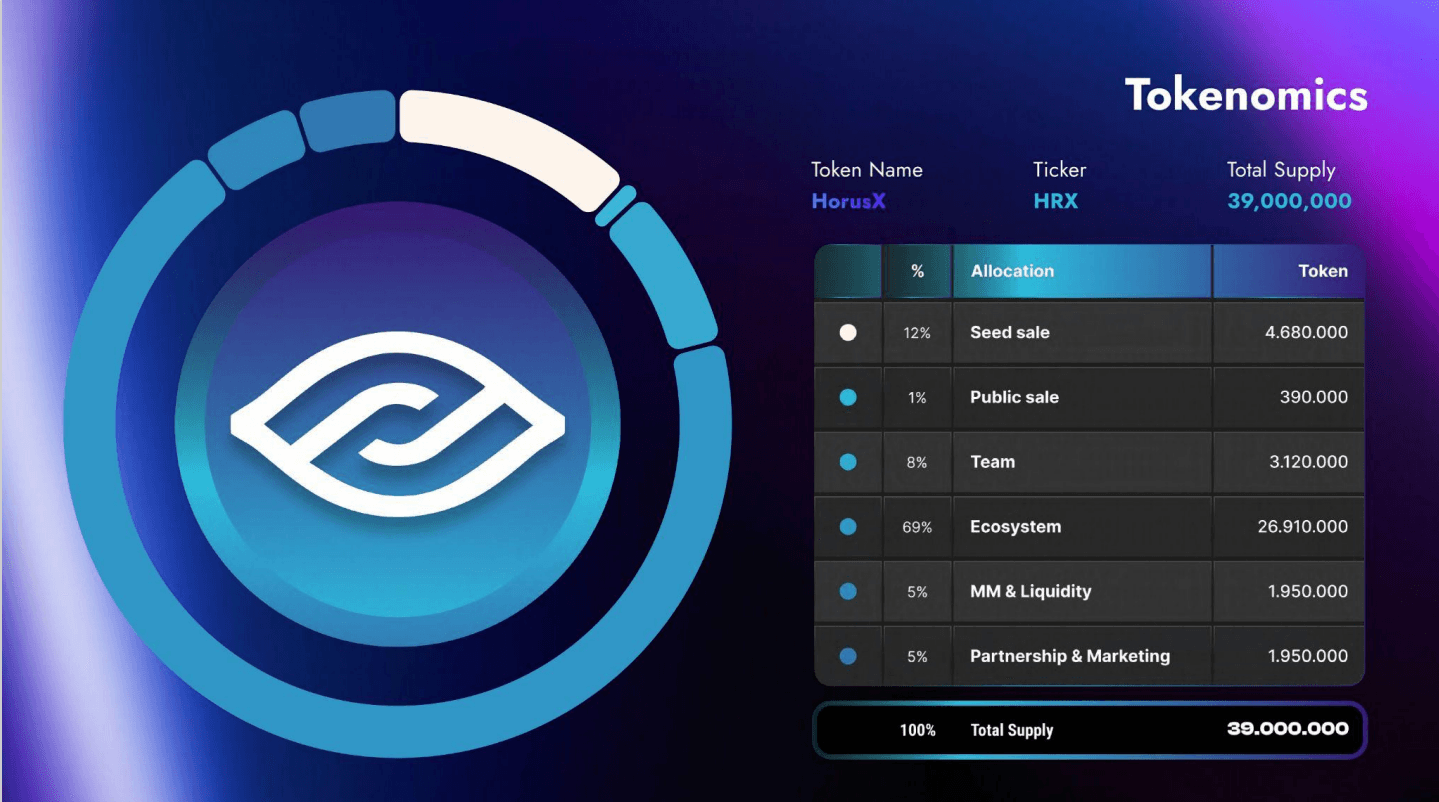
HorusLayer utilise un modèle à double jeton avec 2 jetons natifs principaux : un Jeton de gouvernance et HorusX (HRX) pour l’utilité de l’écosystème. Chaque jeton répond à un objectif unique, offrant aux utilisateurs des opportunités sans précédent de participation à la gouvernance, d’engagement dans l’écosystème et de stabilité au sein de la plateforme HorusLayer.
Mission et vision
Mission HorusLayer :
Démocratiser l’accès aux opportunités financières grâce à la blockchain et à la DeFi, en supprimant les barrières et en favorisant la participation mondiale à l’économie de la cryptographie grâce à des solutions innovantes et conviviales.
Vision:
– Court terme : capturez 30 % de TVL sur Binance Smart Chain, Ethereum, Solana et un autre réseau.
– Long terme : atteindre la liberté et l’autonomisation financières universelles, permettant aux individus de contrôler leurs actifs numériques et leur avenir financier, favorisant l’autonomie, l’innovation et la confiance dans DeFi.
Feuille de route du projet
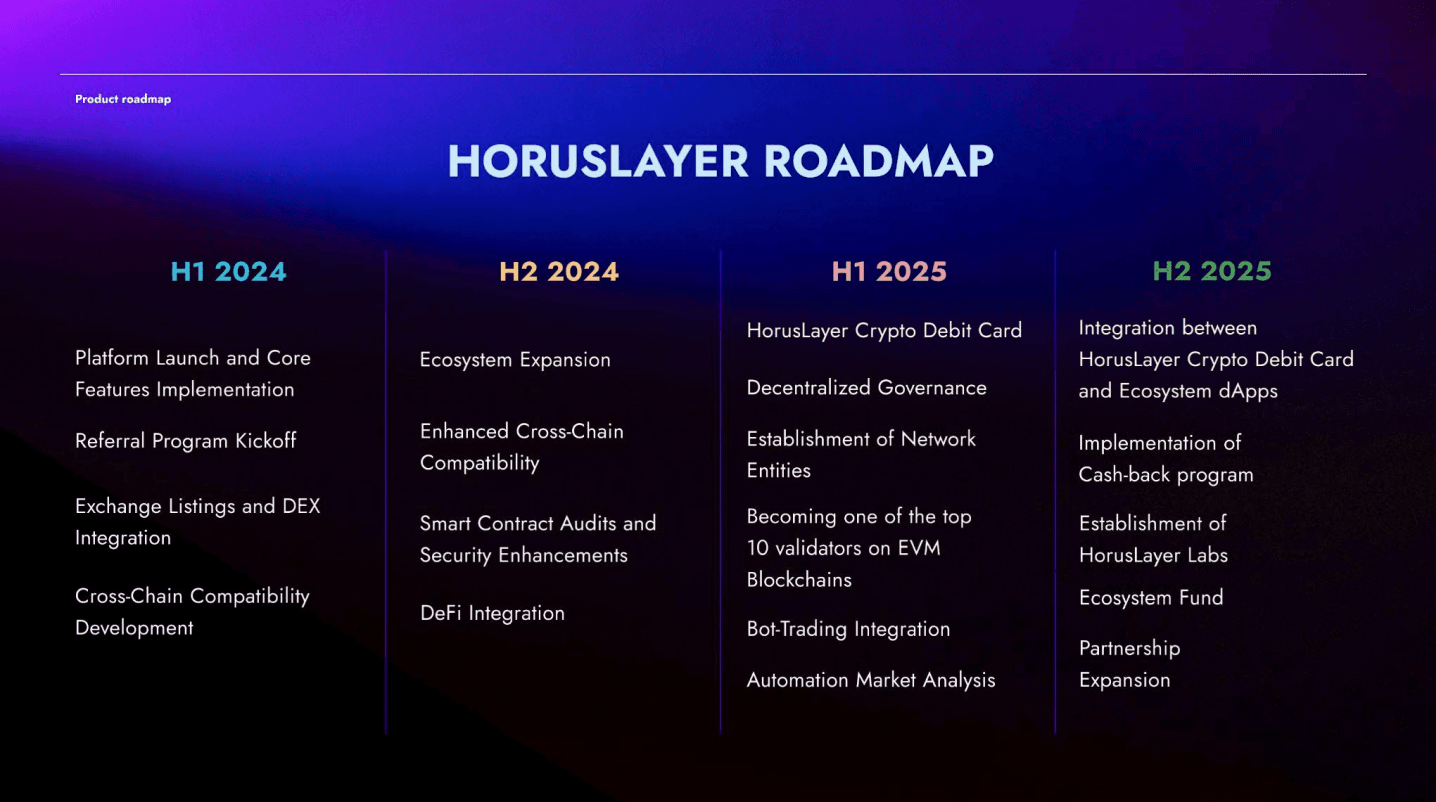
S1 2024 : lancement de la plateforme
- Lancez la plateforme HorusLayer avec jalonnement, LSD, optimisation du rendement et gestion de portefeuille sur BNB, Ethereum, Matic et Solana.
- Démarrez un programme de parrainage et sécurisez les inscriptions sur les principales bourses.
- Développer la compatibilité entre les chaînes.
S2 2024 : Optimisation de la plateforme
- Étendez la prise en charge d’un plus grand nombre de blockchains et d’actifs.
- Améliorez la compatibilité entre les chaînes.
- Réalisez des audits de contrats intelligents et intégrez les protocoles DeFi pour les prêts, les DEX et les pools de liquidités.
S1 2025 : Faire progresser les solutions financières
- Mettre en œuvre le modèle DAO pour une gouvernance décentralisée.
- Établissez des opérateurs de nœuds et un AVS pour la sécurité du réseau.
- Devenez l’un des 10 meilleurs validateurs Ethereum.
- Intégrez le trading de robots et lancez la carte de débit HorusLayer Crypto avec l’intégration DeFi en chaîne et le programme de remise en argent.
S2 2025 : HorusLayer Labs
- Créez HorusLayer Labs pour la R&D dans DeFi.
- Augmenter le financement des projets tiers et améliorer l’infrastructure technique.
- Développez les partenariats stratégiques dans l’espace DeFi.
S1 & S2 2026 : Accessibilité financière
- Lancez les portefeuilles matériels HorusLayer avec jalonnement direct à partir des portefeuilles.
- Renforcez la sécurité et la gestion interconnectée des portefeuilles.
2027 et au-delà : amélioration continue
- Poursuivre la R&D et optimiser l’interopérabilité entre les chaînes.
- Améliorez les fonctionnalités de la plateforme en fonction des commentaires de la communauté et des demandes du marché.
La feuille de route de NovaX souligne l’engagement de l’entreprise à révolutionner le secteur du fitness et à donner aux gens la possibilité d’atteindre leurs objectifs en matière de santé et financiers. Revenons sur certains des tournants les plus importants du parcours de NovaX :
Conclusion
Avec son innovation et son audace, Horuslayer s’impose comme la plateforme de reconversion la plus remarquable en 2024, s’alignant parfaitement sur la tendance future du reconversion. L’équipe professionnelle derrière Horuslayer se consacre non seulement à stimuler l’innovation, mais également à propulser Horuslayer vers de plus hauts sommets. Nous pensons qu’Horuslayer sera un partenaire fiable et indispensable dans le paysage évolutif du resttaking.
Liens officiels
Site web | dApp | Reprise | Télégramme Ann | Chat par télégramme | Twitter | Gitbook | Pont | Coingecko
Clause de non-responsabilité: Ceci est un communiqué de presse payant. BSC.News n’approuve pas et n’est pas responsable du contenu, de l’exactitude, de la qualité, de la publicité, des produits ou d’autres éléments de cette page. L’équipe du projet a acheté cet article publicitaire pour 650 $. Les lecteurs doivent faire leurs propres recherches avant d’entreprendre toute action liée à l’entreprise. BSC.News n’est pas responsable, directement ou indirectement, de tout dommage ou perte causé ou présumé être causé par ou en relation avec l’utilisation ou la confiance accordée à tout contenu, biens ou services mentionnés dans le communiqué de presse.
DeFi
Haust Network Partners with Gateway to Connect to AggLayer

Dubai, United Arab Emirates, August 1, 2024, Chainwire
Consumer adoption of cryptocurrencies is a snowball that is accelerating by the day. More and more people around the world are clamoring for access to DeFi. However, the user interface and user experience of cryptocurrencies still lag behind their fundamental utility, and users lack the simple and secure access they need to truly on-chain products.
Haust Network is a network and suite of products focused on changing this paradigm and bringing DeFi to the masses. To achieve this goal, Haust Network has announced its far-reaching partnership with bridgeseasoned veterans in rapidly delivering revolutionary blockchain utilities for projects. The Gateway team empowers blockchain developers to build DAOs, NFT platforms, payment services, and more. They drive adoption of crypto primitives for individuals and institutions around the world by helping everyone build their on-chain presence.
Gateway specializes in connecting sovereign blockchains to the Aggregation Layer (AggLayer). The AggLayer is a single unified contract that powers the Ethereum bridge of many disparate blockchains, allowing them all to connect to a single unified liquidity pool. The AggLayer abstracts away the complexities of cross-chain DeFi, making tedious multi-chain transactions as easy for the end user as a single click. It’s all about creating access to DeFi, and with Polygon’s technology and the help of Gateways, Haust is doing just that.
As part of their partnership, Gateway will build an advanced zkEVM blockchain for Haust Network, leveraging its extensive experience to deploy ultra-fast sovereign applications with unmatched security, and enabling Haust Network to deliver its products to its audience.
The recently announced launch of the Haust Wallet is a Telegram mini-app that provides users with access to DeFi directly through the Telegram interface. Users who deposit funds into the wallet will have access to all standard send/receive services and generate an automatic yield on their funds. The yield is generated by Haust Network’s interconnected network of smart contracts, Haustoria, which provides automated and passive DeFi yielding.
As part of this partnership, the Haust Network development team will work closely with Gateway developers to launch Haust Network. Gateway is an implementation provider for Polygon CDK and zkEVM technology, which the Haust wallet will leverage to deliver advanced DeFi tools directly to the wallet users’ fingertips. Haust’s partnership with Gateway comes shortly after the announcement of a high-profile alliance with the Polygon community. Together, the three will work to build Haust Network and connect its products to the AggLayer.
About Haust Network
Haust Network is an application-based absolute liquidity network and will be built to be compatible with the Ethereum Virtual Machine (EVM). Haust aims to provide native yield to all users’ assets. In Telegram’s Haust Wallet, users can spend and collect their cryptocurrencies in one easy place, at the same time. Haust operates its network of self-balancing smart contracts that interact across multiple blockchains and then efficiently funnel what has been generated to Haust users.
About Gateway
bridge is a leading white-label blockchain provider that offers no-code protocol deployment. Users can launch custom blockchains in just ten minutes. They are an implementation provider for Polygon CDK and have already helped projects like Wirex, Gnosis Pay, and PalmNFT bring new utility to the crypto landscape.
About Polygon Labs
Polygon Laboratories Polygon Labs is a software development company building and developing a network of aggregated blockchains via the AggLayer, secured by Ethereum. As a public infrastructure, the AggLayer will aggregate the user bases and liquidity of any connected chain, and leverage Ethereum as the settlement layer. Polygon Labs has also contributed to the core development of several widely adopted scaling protocols and tools for launching blockchains, including Polygon PoS, Polygon zkEVM, and Polygon Miden, which is currently under development, as well as the Polygon CDK.
Contact
Lana Kovalski
haustnetwork@gmail.com
DeFi
Ethena downplays danger of letting traders use USDe to back risky bets – DL News

- Ethena and ByBit will allow derivatives traders to use USDe as collateral.
- There is a risk in letting traders use an asset partially backed by derivatives to place more bets.
Ethena has downplayed the dangers of a new feature, which will allow traders to put up its synthetic dollar USDe as collateral when trading derivatives, which are risky bets on the prices of crypto assets.
While allowing users to underwrite their trades with yield-bearing USDe is an attractive prospect, Ethena said there is potential risk in letting traders use an asset partially backed by derivatives to place even more derivatives bets.
“We have taken this risk into account and that is why Ethena operates across more than five different sites,” said Conor Ryder, head of research at Ethena Labs. DL News.
The move comes as competition in the stablecoin sector intensifies.
In recent weeks, PayPal grown up the amount of its stablecoin PYUSD in circulation 96%, while the MakerDAO cooperative plans a rebrandingaiming to increase the supply of its DAI stablecoin to 100 billion.
US dollar growth stagnates
It comes as Ethena has lost momentum after its blockbuster launch in December.
In early July, USDe reached a record level of 3.6 billion in circulation.
That figure has now fallen by 11% to around 3.2 billion.
Join the community to receive our latest stories and updates
New uses for USDe could boost demand for Ethena’s products.
This is where the new plan, announcement Tuesday with ByBit, one of its partner exchanges, is coming.
Ethena users create USDe by depositing Bitcoin or Ether into the protocol.
Ethena then covers these deposits with short positions – bearish bets – on the corresponding asset.
This creates a stable support for USDe, unaffected by price fluctuations in Bitcoin or Ether.
Mitigate risks
While using USDe as collateral for derivatives trading is proving popular, it is unclear what the effects will be if the cryptocurrency market experiences major fluctuations.
Using derivatives as collateral to place more bets has already had disastrous effects.
In June 2022, Lido’s liquid staking token stETH broke its peg to Ether following the fallout from the Terra collapse.
Many traders who used looping leverage to increase their stETH staking yields were liquidated, creating a cascade that caused the price of Ether to drop by more than 43%.
Ethena Labs founder Guy Young said: DL News His office and his partners have taken many precautions.
Ethena spreads bearish bets supporting the USDe across the five exchanges it partners with.
According to Ethena, 48% of short positions supporting USDe are on Binance, 23% on ByBit, 20% on OKX, 5% on Deribit, and 1% on Bitget. website.
In doing so, Ethena aims to minimize the impact of an unforeseen event on a stock market.
The same theory applies to the distribution of risks across different supporting assets.
Fifty percent of USDe is backed by Bitcoin, 30% by Ether, 11% by Ether liquid staking tokens, and 8% by Tether’s USDT stablecoin.
Previous reviews
Ethena has already been criticised regarding the risks associated with USDe.
Some have compared USDe to TerraUSD, an undercollateralized stablecoin that collapsed in 2022.
“It’s not a good design for long-term stability,” said Austin Campbell, an assistant professor at Columbia Business School. said as the USDe launch approaches.
Young replied to critics, saying the industry needs to be more diligent and careful when “marketing products to users who might not understand them as well as we do.”
Ethena has since added a disclaimer on its website stating that USDe is not the same as a fiat stablecoin like USDC or USDT.
“This means that the risks involved are inherently different,” the project says on its website.
Tim Craig is DL News DeFi correspondent based in Edinburgh. Feel free to share your tips with us at tim@dlnews.com.
DeFi
Cryptocurrency and defi firms lost $266 million to hackers in July

In July 2024, the cryptocurrency industry suffered a series of devastating attacks, resulting in losses amounting to approximately $266 million.
Blockchain Research Firm Peck Shield revealed in an X post On August 1, attacks on decentralized protocols in July reached $266 million, a 51% increase from $176 million reported in June.
The most significant breach last month involved WazirX, one of India’s largest cryptocurrency exchanges, which lost $230 million in what appears to be a highly sophisticated attack by North Korean hackers. The attack was a major blow to the stock market, leading to a break in withdrawals. Subsequently, WazirX launched a program in order to recover the funds.
Another notable incident involved Compound Finance, a decentralized lending protocol, which suffered a governance attack by a group known as the “Golden Boys,” who passed a proposal who allocated 499,000 COMP tokens – valued at $24 million – to a vault under their control.
The cross-chain liquidity aggregation protocol LI.FI also fell victim On July 16, a hack resulted in losses of $9.73 million. Additionally, Bittensor, a decentralized machine learning network, was one of the first protocols to suffer an exploit last month, loming $8 million on July 3 due to an attack targeting its staking mechanism.
Meanwhile, Rho Markets, a lending protocol, suffered a $7.6 million breach. However, in an interesting twist, the exploiters research to return the stolen funds, claiming the incident was not a hack.
July 31, reports The Terra blockchain protocol was also hacked, resulting in a loss of $6.8 million across multiple cryptocurrencies. As crypto.news reported, the attack exploited a reentrancy vulnerability that had been identified a few months ago.
Dough Finance, a liquidity protocol, lost $1.8 million in Ethereum (ETH) and USD Coin (USDC) to a flash loan attack on July 12. Similarly, Minterest, a lending and borrowing protocol, saw a loss of $1.4 million due to exchange rate manipulation in one of its markets.
Decentralized staking platform MonoSwap also reported a loss of $1.3 million following an attack that allowed the perpetrators to withdraw the liquidity staked on the protocol. Finally, Delta Prime, another decentralized finance platform, suffered a $1 million breach, although $900,000 of the stolen funds was later recovered.
DeFi
The Rise of Bitcoin DeFi: Then and Now

The convergence of Bitcoin’s robust security and Layer 2 scaling solutions has catalyzed the emergence of a vibrant DeFi ecosystem.
By expanding Bitcoin’s utility beyond simple peer-to-peer payments, these advancements have opened up a new frontier of financial possibilities, allowing users to participate in decentralized lending, trading, and other complex smart contract operations on Bitcoin.
Read on to learn about the rise of Bitcoin-based decentralized finance and how the space has expanded to accommodate a new generation of native assets and features.
Note: If you want to learn candlesticks and chart trading from scratch, this is the best book available on Amazon! Get the book now!
What is DeFi?
Decentralized finance (DeFi) represents a paradigm shift in financial services, offering internet-based financial products such as trading, lending, and borrowing through the use of decentralized public blockchains.
By implementing blockchains, smart contracts, and digital assets, DeFi protocols provide financial services through a decentralized ecosystem, where participants do not have to deal with intermediaries when transacting.
What is Bitcoin DeFi?
The inherent limitations of the Bitcoin mainchain in supporting the intricacies of decentralized finance have created the need to develop smart contract-based Layer 2 solutions.
Additionally, the advent of the Ordinals protocol in 2023, which facilitated the emergence of fungible token standards such as BRC-20 and Runes, catalyzed the growth of DeFi on the Bitcoin blockchain.
This expansion in protocol diversity has broadened the applications of the world’s leading cryptocurrency network beyond the core base-layer use cases around value preservation and transactional capabilities.
Therefore, Bitcoin DeFi has become a nascent sector within the digital asset market, after previously being a missing essential part of the Bitcoin ecosystem.
Bitcoin DeFi in its early days
Integrating decentralized finance (DeFi) concepts into the Bitcoin ecosystem has been a journey of innovation and perseverance. Early attempts to bridge the gap between Bitcoin’s fundamental simplicity and DeFi’s complexities have spawned pioneering projects that, while laying essential foundations, have also encountered significant obstacles.
Colored coins
Colored coins represented an early foray into tokenizing real-world assets on the Bitcoin blockchain. By leveraging the existing network to track ownership of assets ranging from stocks to real estate, this approach highlighted Bitcoin’s potential as a platform beyond digital currency. However, scalability and practical implementation challenges have limited its widespread adoption.
Counterpart
Building on the colored coins, Counterparty has become a platform for creating and trading digital assets, including non-fungible tokens (NFTs), on Bitcoin.
The introduction of popular projects like Rare Pepe NFTs has demonstrated the growing appeal of digital collectibles. However, constraints around user experience and network efficiency have hampered its full potential.
These early experiments, while not fully realizing their ambitions, served as valuable stepping stones, informing Bitcoin DeFi’s subsequent developments. Their challenges highlighted the need for more sophisticated infrastructure and protocols to harness the full potential of decentralized finance on the Bitcoin network.
Bitcoin DeFi Today
Today, building DeFi applications on Bitcoin is primarily done in the realm of Layer 2 (L2) networks. This architectural choice is motivated by the limitations of Bitcoin’s base layer in supporting complex programmable smart contracts.
Bitcoin’s original design prioritized security and decentralization over programmability, making it difficult to develop sophisticated DeFi protocols directly on its blockchain. However, the recent emergence of protocols like Ordinals, BRC-20, and Runes, while not DeFi in their own right, has sparked possibilities for future DeFi-like applications on the main chain.
In contrast, L2 solutions offer a scalable and programmable environment built on Bitcoin, enabling the creation of various DeFi products.
By expanding Bitcoin’s capabilities without compromising its core principles, L2s have become the preferred platform for developers looking to build DeFi applications that encompass trading, lending, staking, and more.
Leading L2 networks such as Lightning Network, Rootstock, Stacks, and Build on Bitcoin provide the infrastructure for these efforts. Some of these L2s have even introduced their own native tokens to the network, further expanding Bitcoin’s DeFi ecosystem.
Essentially, while Bitcoin’s core layer presents challenges for DeFi development, its security and decentralization have provided a foundational layer for the innovative L2 landscape to thrive.
Bitcoin Layer 2 offers a promising path to building a robust and thriving Bitcoin-based DeFi ecosystem that offers trading, staking, lending, and borrowing. All you need is a DeFi Wallet like Xverse to access the new world of decentralized financial services secured by Bitcoin.
Conclusion
The integration of DeFi principles into the Bitcoin ecosystem, primarily facilitated by Layer 2 solutions, marks a significant evolution in the digital asset landscape.
Building on the foundational work of pioneers like Colored Coins and Counterparty, the industry has evolved into more sophisticated platforms like Rootstock, Stacks, and Build on Bitcoin to create a thriving Bitcoin-powered DeFi ecosystem.
Advertisement
-

 News11 months ago
News11 months agoBitcoin soars above $63,000 as money flows into new US investment products
-

 DeFi11 months ago
DeFi11 months agoEthena downplays danger of letting traders use USDe to back risky bets – DL News
-

 News11 months ago
News11 months agoFRA Strengthens Cryptocurrency Practice with New Director Thomas Hyun
-

 DeFi11 months ago
DeFi11 months agoZodialtd.com to revolutionize derivatives trading with WEB3 technology
-

 Markets11 months ago
Markets11 months agoBitcoin Fails to Recover from Dovish FOMC Meeting: Why?
-

 DeFi1 year ago
DeFi1 year ago👀 Lido prepares its response to the recovery boom
-

 DeFi1 year ago
DeFi1 year agoPancakeSwap integrates Zyfi for transparent, gas-free DeFi
-

 DeFi1 year ago
DeFi1 year ago🏴☠️ Pump.Fun operated by Insider Exploit
-

 Markets1 year ago
Markets1 year agoa resilient industry that defies market turbulence
-

 DeFi1 year ago
DeFi1 year ago👀SEC Receives Updated Spot Ether ETF Filings
-

 DeFi1 year ago
DeFi1 year ago🚀 S&P says tokenization is the future
-

 DeFi1 year ago
DeFi1 year ago⏱️ The SEC is not rushing the commercialization of Spot Ether ETFs







